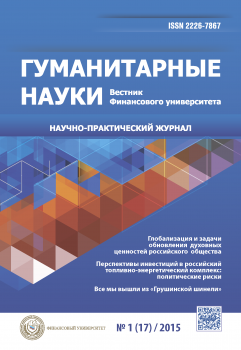This article is devoted to the dynastic myth of the Rurikids and its cultural and religious grounds as an example of positive stateforming historical mythology. The problem of historical mythology now takes on a new urgency. On the one hand, a broad public debate about the falsification and demythologizing history goes on. On the other hand, the development of the historical consensus as one of the fundamental elements of the Russian state ideology is on the agenda. The author postulates that along with the deliberate falsification of history, there are, in fact opposite to it, positive historical myths included in the national consciousness and that became key components of the cultural and historical identity. Development of positive historical myth for any state, for any nation is the inevitable and desirable process. As an example of such myth the article considers the historical dynastic mythology of state of the Rurikids in Kiev and Moscow period. Particular attention is paid to the period’s literary monuments in which the dynastic myth was reflected and developed. Its development is Traced from the «Tale of Bygone Years» to «Book of Degrees». The article Shows how the Old Russian writers and chroniclers disclose basic, sacred meaning of existence of the Russian state. Often it happens through the formal distortion, in the opinion of the modern researchers, of historical fact. However, the perception of the historical text in the Middle Ages differed from the modern. Approximation of described reality to the ideal one through biblical allusions and paraphrases contributed only, in the opinion of the medieval author, to the establishment of genuine truth. The Myth sacralized the reign of the ruling dynasty, playing a significant positive role in the construction of the Russian state.
Old Russian literature, Ancient Rus’, historical mythology, Muscovy, Rurikids, Middle Ages.
Статья подготовлена в рамках проекта «Влияние исторических фальсификаций и мифов на сознание и социальное поведение современной российской молодежи». При реализации проекта используются средства государственной поддержки, выделенные в качестве гранта в соответствии с распоряжением Президента Российской Федерации от 17 января 2014 г. № 11-рп и на основании конкурса, проведенного Фондом ИСЭПИ.
Можем ли мы сегодня с уверенностью сказать, что хорошо знаем страницы истории нашей Родины, отделенные от нас более чем шестью с половиной веков? Конечно, нет. Историчность, так же, как и легендарность, того или иного события в прошлом сложно доказуема. Связано это с тем, что источники, повествующие нам о событиях прошлого, подлежали многократной переделке; таким образом, вопрос об их надежности сложен. Известные исторические личности прошлого сегодня для нас являются собирательными образами, вмещающими в себя не только черты характера, образ мыслей и поступки человека того времени, но и черты самой эпохи и, конечно, ту народную молву, которая сложилась о нем тогда. Эта молва, сегодня уже окутанная туманом легенд и мифов, прочно вошла в наше сознание. Легендарными чертами были награждены практически все исторические лица, своей деятельностью внесшие весомый вклад в ту или иную сферу общественно-политической жизни страны.
1. Gal’biati E., P’yatstsa A. Trudnye stranitsy Biblii (Vetkhiy Zavet) [Difficult pages of the Bible (Old Testament)]. Milan; Moscow, Christian Russia Publ., 1992. 306 p.
2. Rybakov B.A. Kievskaya Rus’ i russkie knyazhestva XII-XIII vv. [Kievan Rus and the Russian principalities in XII-XIII centuries]. Moscow, Nauka Publ., 1993. 592 p.
3. Gol’dberg A.L. Ideya «Moskva - Tretiy Rim» v tsikle sochineniy pervoy poloviny XVI v. [The idea of «Moscow is the Third Rome» in a series of works of the first half of the XVI century]. Trudy Otdela drevnerusskoy literatury [Proceedings of the Department of Old Russian literature]. V. 37. Moscow, 1983. pp. 139-149.
4. Likhachev D.S., Dmitriev L.A., Alekseev A.A., Ponyrko N.V. Skazanie o knyaz’yakh vladimirskikh [The Tale of the Princes of Vladimir]. Biblioteka literatury Drevney Rusi [Library literature of Ancient Russia]. Rossiyskaya akademiya nauk. Institut russkoy literatury [Russian Academy of Sciences. Institute of Russian Literature]. St. Petersburg, Pushkin House Publ., 2000. V. 9: End of XIV - first half of XVI century, pp. 250-285.
5. «Izlozhenie paskhalii» moskovskogo mitropolita Zosimy [«Statement paschal» by Moscow Metropolitan Zosima]. Issledovaniya po istochnikovedeniyu istorii SSSR XIII-XVIII vv. [Research on chronology of the USSR XIII-XVIII centuries]. Moscow, Nauka Publ., 1986, pp. 46-62.
6. Stepanov N.V. Novyy stil’ i pravoslavnaya paskhaliya [The new style and the Orthodox Paschal]. Moscow, 1907. 29 p.
7. Belyakovy L.L. i E.V. O peresmotre eskhatologicheskoy kontseptsii na Rusi v kontse KhV veka [On the revision of the eschatological concept in Russia at the end of the XV century]. Arkhiv russkoy istorii [Archives of Russian history]. V. 1. Moscow, TsGADA Publ., 1992, pp. 7-31.
8. Alekseev A.I. Zametki o peresmotre eskhatologicheskoy kontseptsii na Rusi v kontse XV v. [Notes on the revision of the eschatological concept in Russia at the end of the XV century]. Srednevekovoe pravoslavie: ot prikhoda do patriarkhata [Medieval orthodoxy: from the parish to the patriarchy]. V. 1. Volgograd, Publishing House of the University of Volgograd, 1997, pp. 111-126.
9. Slovar’ knizhnikov i knizhnosti Drevney Rusi [Dictionary of the scribes and literature of ancient Russia]. Leningrad, Nauka, 1989. V. 2. Part 2. 528p.
10. Lur’e Ya.S. Ideologicheskaya bor’ba v russkoy publitsistike kontsa XV - nachala XVI veka [The ideological struggle in Russian journalism late XV - beginning of XVI century]. Moskow-Leningrad, Publishing House of the USSR Academy of Sciences, 1960. 534 pp.
11. Malinin V.N. Starets Eleazarova monastyrya Filofey i ego poslaniya [The elder Philotheus of the Eleazar Monastery, and his messages]. Kyiv, 1901. 1032 p.
12. Gol’dberg A.L. Tri «poslaniya Filofeya» [Three «message Philotheus»]. Trudy otdela drevnerusskoy literatury [Proceedings of the Department of Old Russian literature]. V. 29. Leningrad, 1974, pp 68-97.
13. Sinitsyna N.V. Tretiy Rim: Istoki i evolyutsiya russkoy srednevekovoy kontseptsii (XV-XVI vv.) [Third Rome: The Origins and Evolution of Russian medieval concept (XV-XVI centuries)]. Moskow, Indrik Publ., 1998. 416 p.
14. Plotnikova O.A., Shilov N.A. Ideologiya tsentralizatsii Moskovskogo knyazhestva (po materialam literaturnykh pamyatnikov) [The ideology of centralization of the Moscow principality (based on literary works)]. Nauchnye trudy Moskovskogo gumanitarnogo universiteta [Proceedings of the Moscow Humanitarian University]. 2014, I. 3, pp. 16-24.





